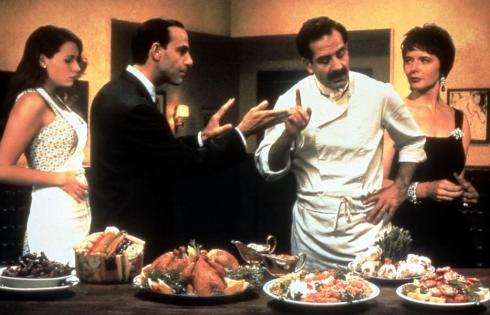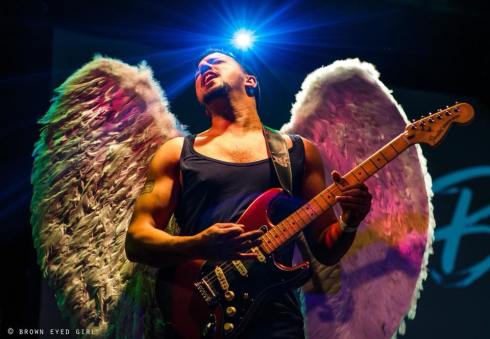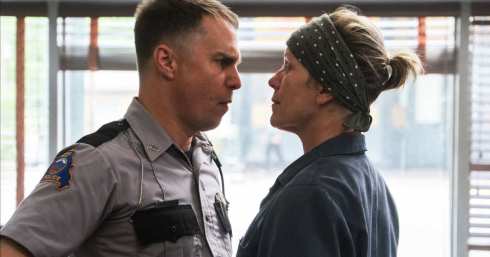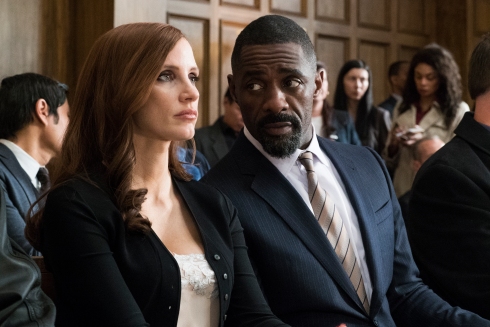
Bompas & Parr’s inaugural London Food Film Festival opened with Big Night, starring (left to right) Minnie Driver, Stanley Tucci, Tony Shalhoub and Isabella Rossellini
Bompas & Parr are the Willie Wonkas of London. For ten years now they have been staging elaborate food- and drink-related events for any brand that cares – or should that be dares? – to commission them. You want a cityscape made of jelly? A lake of Courvoisier punch large enough for people to row across? Or perhaps you merely want to launch some coffee beans into the stratosphere to create the world’s “Space Coffee”? You know who you’re gonna call.
Already this year Bompas & Parr have created a Cryptozoological Haggis Workshop for Burns Night, a Seismic Sound Bath in Christie’s Gallery, and, now, this week, the first annual London Food Film Festival at the Curzon Mondrian cinema on the South Bank. I went to the opening night last night: a screening of Stanley Tucci’s Big Night (1996) chosen and hosted by Evening Standard food critic Grace Dent.
It was a lovely film, only slightly marred by the eccentric decision to show it with Malay (I think) subtitles: the Italian sections of dialogue were expressive enough that you got the sense of them anyway! About a struggling restaurateur whose chef brother refuses to compromise his art for the philistine clientele, Big Night was funny and not a little heartbreaking. As Dent said, “Restaurants are giant money pits and they will take you under, both financially and emotionally. In this film we see the struggle between authenticity in cuisine and being profitable.”
I feel Bompas & Parr may have missed a trick by not combining food with the film: after watching the great Italian feast that dominates the final act of the film, we hungrily repaired afterwards to the nearest Italian restaurant, the Gourmet Pizza on South Bank – as did at least one other table of diners. A few years ago, by contrast, I went to a terrific event in the basement of Gordon Ramsay’s Union Street Café which combined a screening of GoodFellas with Italian dishes and cocktails appropriate to the action. Ah well, maybe next year.
Before the screening, Sam Bompas explained how the festival was all part of their attempts to put together a Museum of Food: “Four years ago we were trudging around the Design Museum thinking, who gets excited about chairs? But everyone gets excited about food. So we went to lots of brands, to government bodies, and said we need a British Food Museum. And they all told us to get lost. So we thought we’d do it anyway.”
Their first attempt took the form of a three-month pop-up at Borough Market in 2015. “We had this interactive exhibition called ‘Be the Bolus’ in which you become a bit of food being eaten. You sit on a modified massage chair that vibrates and expands around you like you’re going down a digestive tract.”
The London Food Film Festival, too, falls under the Museum of Food umbrella. “We’re on the verge of a permanent home in London,” he says tantalisingly, “and in February we will release a programme, but this is the first thing we’re doing.”
At time of writing there were still tickets for the rest of the festival. Tonight (Tuesday) writer and Psychogourmet Geoff Nicholson presents La Grande Bouffe and Jiro Dreams of Sushi; on Wednesday, director Jamie Jay Johnson and comedian Seb Cardinal present “A culinary ramble through the very best in Food and Film” (excerpts from their favourite food moments on screen) and Tampopo; and on Thursday, Sam Bompas himself takes over the reins. Be afraid. Be very afraid.
“I was worried we’d run out of great food films for next year,” he confessed, “so I thought I would look at cannibalism in cinema [of course, as you would!], and show The Descent.
“I did want people to taste human flesh in some way,” he continued, “but I got an email from the human tissue organisation saying ‘stop what you are doing, it’s incredibly illegal’. But we will have a skull to drink from.” So that’s all right, then.
Bompas & Parr, you crazy geniuses, we salute you. Of course there should be a Food Museum. And as long as they’re behind it, I’ll be first in line





